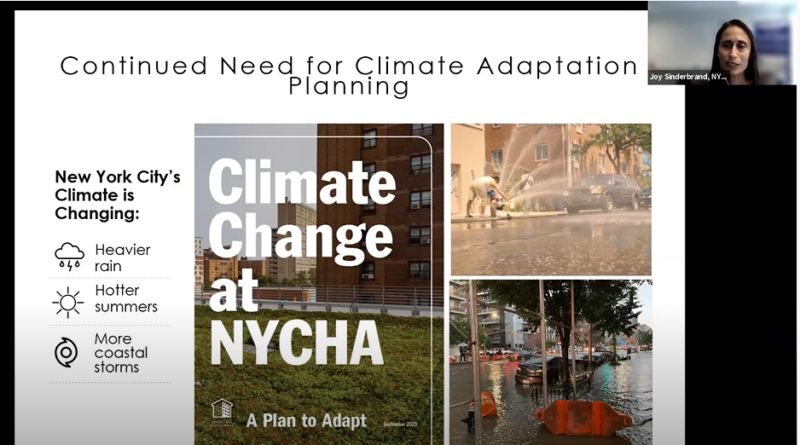Protecting Public Housing from the Impacts of Climate Change
On September 24, Joy Sinderbrand, NYCHA’s Vice President for the Recovery and Resilience Department in Capital Projects, participated in a virtual panel organized by Enterprise Community Partners and Resilience 21. The panel, titled “Climate Change and Housing – How NYC Is Protecting Its Affordable Housing,” was part of New York City’s Climate Week events, and was moderated by Eric Wilson, Director of Housing at the NYC Mayor’s Office of Climate Resiliency (MOCR).
More than 80 people from all over the world participated in the virtual panel, most of them experts in resiliency, public housing, and climate change. During the event, New York housing experts discussed projects that have been launched recently to protect the city’s affordable housing stock from climate risks.
Eric Wilson from MOCR stressed that current and future buildings in New York should be designed with climate resiliency in mind. Starting in 2027, certain City-funded capital projects will be required to use resilient design guidelines. These guidelines are being developed now.
Laurie Schoeman, National Director of Resilience for Enterprise Community Partners and Co-Facilitator of Resilience 21, emphasized the need for resilient public housing initiatives. The panel explored case studies of resilient housing that should be used as a model for housing across the nation.
NYCHA’s Joy Sinderbrand presented the work that the Authority has been doing to repair the damage caused by Superstorm Sandy and the steps that NYCHA is taking to protect developments and residents from the impacts of all types of climate change, including extreme heat, extreme cold, and heavy rainfall. Ms. Sinderbrand gave a sneak peek of NYCHA’s soon-to-be-published Climate Adaptation Plan, highlighting the need for a multi-hazard mitigation approach for New York’s public housing, including developments that will be in the PACT program.
“We’re working closely with the Real Estate Department to make sure that all the information we know about the risks in a particular development get embedded into the requirements for development partners,” said Ms. Sinderbrand.
According to Ms. Sinderbrand, NYCHA’s goals include building resilience into NYCHA’s capital work, fostering the health of NYCHA’s urban forest, investing in social resilience at NYCHA, expanding access to reliable heating, providing efficient cooling in NYCHA apartments, preparing developments to manage heavier and more frequent rainstorms, and protecting critical infrastructures at developments exposed to coastal flooding.
“This is moving away from component-based replacement in NYCHA buildings and thinking about top-to-bottom renovations,” Ms. Sinderbrand noted. “NYCHA recently put together a ‘white paper’ guiding this process: Climate adaptation and sustainability are really at the forefront of the thinking behind the other components.”
On September 27, Mayor Bill de Blasio released “The New Normal: Combatting Storm-Related Extreme Weather in New York City,” a landmark report that provides New York City with a new set of protocols and policies to protect New Yorkers from extreme weather. The mayor announced plans to support the report’s recommendations with $2.5 billion in new capital funding across City agencies, including additional investment in stormwater management at NYCHA campuses.







